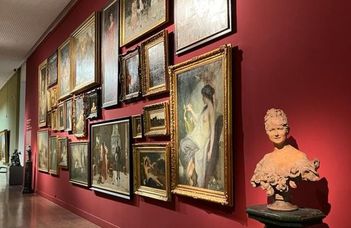Erasmus students at the National Gallery

The Comparative Literary and Cultural Studies class visited the Hungarian National Gallery
Thoughts from Johanna and Alina
We met on the 11th of October at 10 am, a rainy Saturday. The perfect day to go to the museum. We started on the first floor and looked at the statues and paintings there. Dr. Marton Hoványi did not just tell us about the history and interpretation of the art but encouraged us to take a critical look for ourselves and went into an open discussion with us throughout our museum visit. We talked about our thoughts on the different colours the painters used and their intention behind those colours used, the placement of the people presented and the usage of light and shadow.
Two paintings that really stuck with us (once we went to the second floor of the museum) were the Cellist by Róbert Berény and the Woman with a Birdcage by József Rippl-Rónai. The paintings both show a woman but while Berény’s painting portrays the woman becoming one with her music and gives the recipient a feeling of freedom, Rippl-Rónai by using only dark colours and almost no movement paints the picture of a woman stuck not only in the room she is in but also in sadness and loneliness. She holds a birdcage in her hand and looks like she is about to drop it which gives the recipient the smallest hint of rebellion against who or whatever is holding her captive. Both paintings take you on an emotional journey and give you the possibility to interpret and find new details the longer you spend time with them.
After looking at a lot of smaller paintings that begged us to take a closer look and take in every single stroke of the painters’ brush we ended the tour of the gallery on a bigger painting, namely Ruins of the Ancient Greek Theatre at Taormina by Tivadar Csontváry Kosztka. This painting can be experienced just like the ones before by stepping close to it and examining small details but you cannot experience the full beauty of it if you do not step away and look at it in its entirety. Even though the painter used colours that do not instinctually fit, yellow and green for the sky, and dark blue for the mountain, the painting does make sense and the confusion of colours adds to its appeal.
All in all, the visit to the Hungarian National Gallery was very interesting and presented a great opportunity to not only get a look at famous pieces of art but explore them together.




